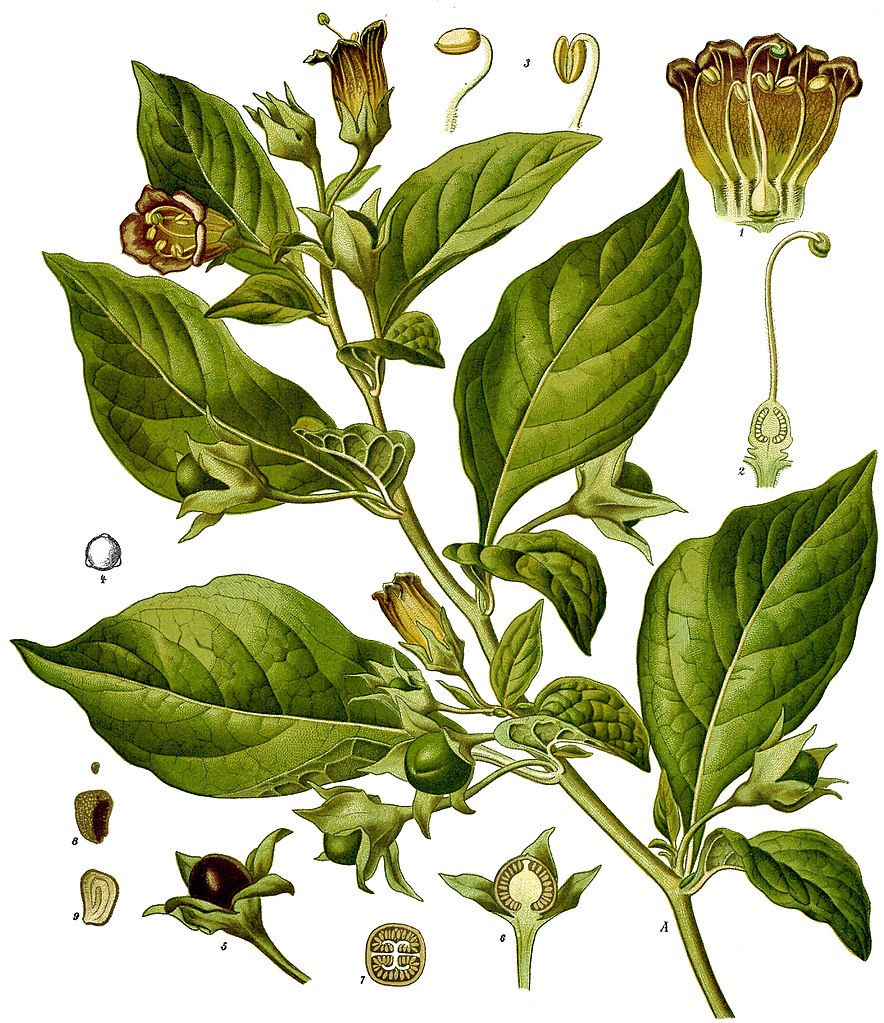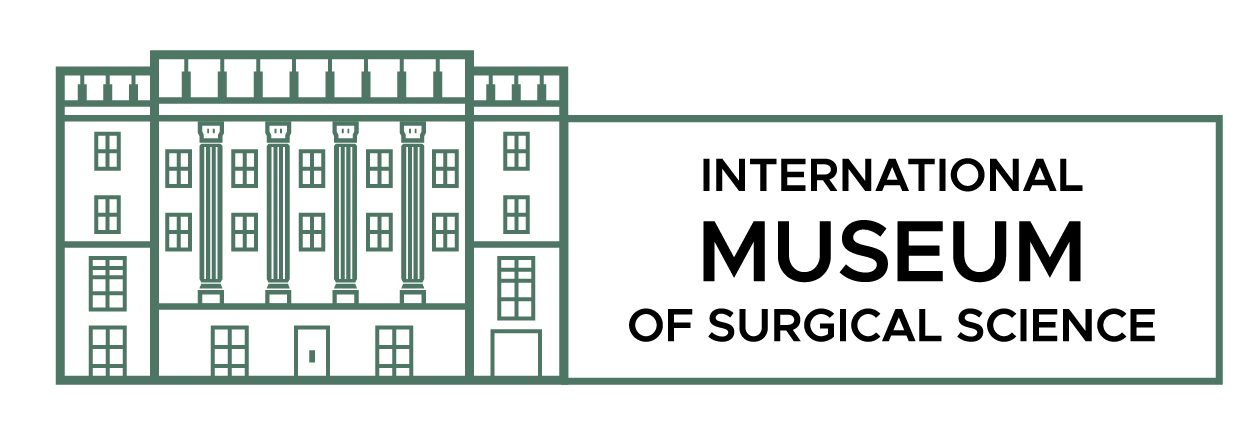Published by Bailey Kirsten
“Beauty is pain!” one may think as they stuff their feet into 6-inch pumps, or meticulously tweeze their brows into the perfect arch. How far, however, might someone be willing to step over the line separating minor discomfort and extreme agony in order to get that special compliment from a stranger on the street? A medieval Venetian woman may be able to tell you, with a little help from a strikingly beautiful purple plant called belladonna.

A scientific illustration showing the inside of the Belladonna plant. Franz Eugen Köhler, Köhler’s Medizinal-Pflanzen, 1897, Wikimedia Commons.
Christened by the father of taxonomy himself Carl Linnaeus, Atropa belladonna is a perennial herbaceous plant in the nightshade family- hence why you may also recognize this plant by its second, much less appealing nickname: deadly nightshade. The nickname is quite fitting, as every part of the plant is extremely deadly when ingested, particularly its foliage and its shiny, black, and apparently sweet-tasting berries. The plant’s genus name, Atropa, comes from Atropos, one of the three Moirai, or the ‘Three Fates’, in Greek mythology. Along with her sisters, Clotho and Lachesis, Atropos and the Fates controlled the destiny of every human. Clotho spun the thread of life, Lachesis measured it, and Atropos, whose name means ‘inflexible’, severed it, deciding for herself how each human would die, and when. The species name, belladonna, is Italian for beautiful woman. This name may be in reference to a tonic made from the nightshade’s berries that women would powder on their skin to create a blush-like appearance. However, more likely, it is in reference to the Venetian women of the Renaissance who used eye drops made from the berry’s juice that would dilate the pupil, giving off a seductive and striking appearance. These women would probably not be keen to learn that these berries are also known as sorcerer’s berries, devil’s berries, or murderer’s berries.

The deadly black berries of the Belladonna plant. The berries have a sweet taste and often grow close to the ground, putting children especially at risk. Wikimedia Commons.
The compounds that give belladonna its toxicity are the tropane alkaloids atropine (sound familiar?), scopolamine, and hyoscyamine. These alkaloids act as anticholinergics, targeting the central nervous system causing not only the dilated pupils mentioned above, but rapidly increased heart rate, vomiting, sensitivity to light, delirium, hallucinations, and eventually convulsions, coma, and death. The hallucinations experienced by belladonna are said to have drastically different properties than the ones commonly experienced by serotonin-releasing hallucinogens like psilocybin mushrooms or peyote. Belladonna hallucinations can last for days at a time, the victim experiencing bizarre delirium, memory disruption, extreme confusion, and general discomfort and unpleasantness. Many also claimed to experience the sensation of flying.
These ‘flying sensations’ may have contributed to the myth of the witches’ Flying Ointment. Legend has it that witches of the late middle ages would use belladonna, along with other plants like hemlock, wolfsbane, and mandrake, in their brews and salves, anointing it to various parts of their bodies to allow them to fly on their broomsticks. It is also possible these women may have been applying the salves vaginally to treat gynecological ailments. This type of application would also cause the alkaloids of belladonna to enter the body much quicker and more aggressively. In addition to these myths, the plant is also prevalent in popular culture. Belladonna is likely the poison used by the star-crossed lovers Romeo and Juliet to end their heartbroken lives. The symptoms described by Shakespeare in his prose are eerily similar to the effects of the nightshade:
Her blood is settled, and her joints are stiff; Life and these lips have long been separated. Death lies on her like an untimely frost Upon the sweetest flower of all the field.
Romeo and Juliet, Act IV, Scene v
Its use as a poison does not end in fiction, however. The plant’s utilization in real life assassinations and biological warfare is surprisingly (or unsurprisingly?) historied. The Roman’s supposedly used belladonna to contaminate their enemies’ food reserves. Macbeth of Scotland used it to poison the liquor supply of invading troops from England. Roman emperors Claudius and Augustus were both poisoned with belladonna by their wives.

Belladonna extract drug bottle, c. 1890, Collection of the International Museum of Surgical Science.
Despite all of the death, destruction, and hysteria the belladonna plant has caused, it can still be utilized medicinally when used correctly. Atropine, despite its toxicity in large quantities, can be effective at regulating the heart rate and relaxing muscle spasms. The plant, combined with other medications, can be used to treat IBS, spastic colon, stomach ulcers, Parkinson’s disease, motion sickness, and pink eye, among others. It’s also quite likely you (yes, you! Reading this!) have experienced the effects of belladonna. Similar to how the Venetian women of the Renaissance used it, belladonna is still used today to dilate the pupils during an eye exam at the optometrist, although in much smaller quantities than in the days of old. Wielding this little purple plant can bring chaos or salvation, depending on the hand that holds it.
Works Cited
Berdai, Mohamed Adnane, et al. “Atropa Belladonna Intoxication: a Case Report.” The Pan African Medical Journal, The African Field Epidemiology Network, 2012, www.ncbi.nlm.nih.gov/pmc/articles/PMC3361210/.
“The Powerful Solanaceae: Belladonna.” U.S. Forest Service, www.fs.fed.us/wildflowers/ethnobotany/Mind_and_Spirit/belladonna.shtml.
“Macbeth of Scotland.” Herbology Manchester, Manchester Museum Herbarium , 23 Mar. 2015, herbologymanchester.wordpress.com/tag/macbeth-of-scotland/.
Mann, John. “Belladonna, Broomsticks and Brain Chemistry.” RSC Education, Royal Society of Education, 1 Jan. 2008, edu.rsc.org/feature/belladonna-broomsticks-and-brain-chemistry/2020099.article.
Micke, M.M. (1996), The Case of Hallucinogenic Plants and the Internet. Journal of School Health, 66: 277-280. doi:10.1111/j.1746-1561.1996.tb03397.x
Bailey Kirsten is the Spring 2020 Permanent Collections Intern at the International Museum of Surgical Science. She is a junior Anthropology student at the University of Illinois-Chicago and has a deep passion for history, archaeology, and environmental science. When not daydreaming of being a park ranger deep in the Rocky Mountains, she’s probably watching Cold War documentaries.


